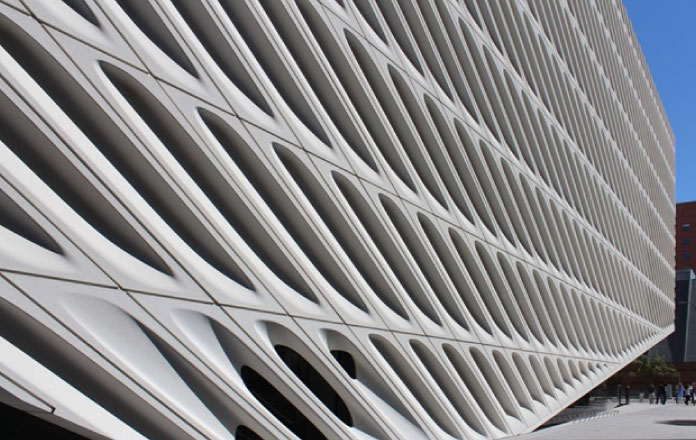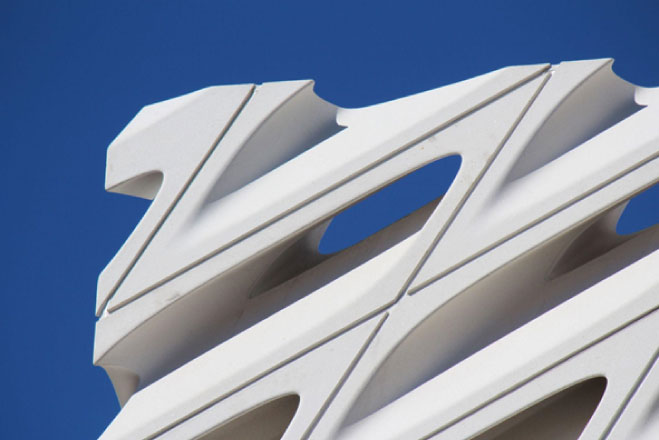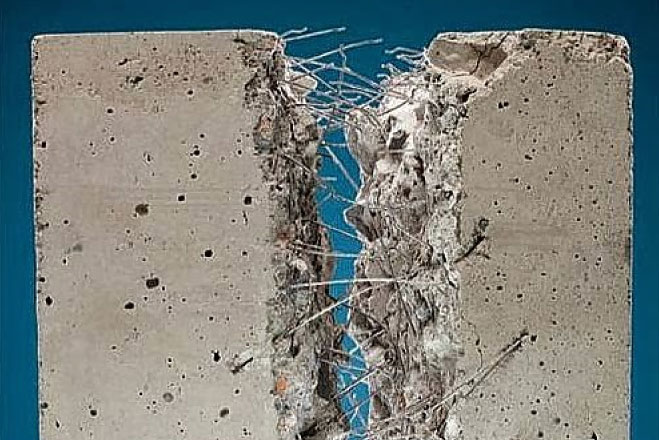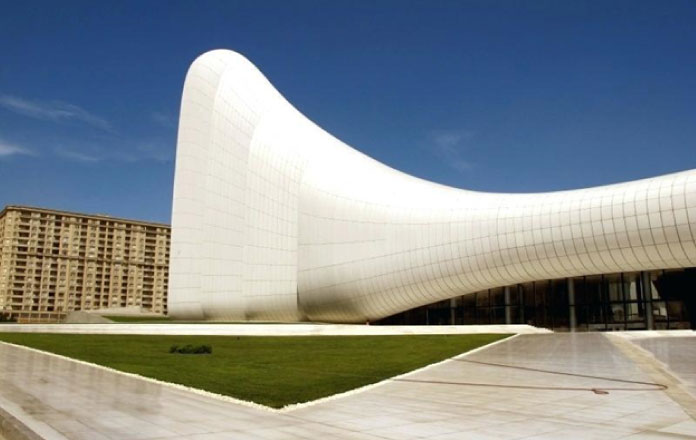Glass fiber reinforced concrete (GFRC) has been used in building facades for a long time and was originally designed for its excellent performance in seismic zones. The decorative concrete industry adopted it not just for its strength, but also for the diversity it offers in terms of texture, color, and form, which would otherwise be unachievable with traditional precast.
The fundamental principles of GFRC are straightforward. A cement-rich blend, comprising one part cement and one part graded, dry sand, is used in most mixed designs. GFRC is commonly cast at 0.75″ to 1″ thick with the addition of water, curing polymer, and glass fiber for reinforcing. Mixes can be adapted for spraying or plasticized using water reduced to produce self-consolidating concrete.

Glass Fibre Reinforced Concrete Preparation (GFRC)
Weight can add glass fibers ranging in length from 10mm to 50mm and diameter from a few microns up to 5% and premixed with cement and water in a pan or a paddle mixer. Lubricating admixtures such as polyethylene oxide or methylcellulose may be added in small amounts to the mix. The finished mixture can be sprayed or poured into the molds. The goods can also be manufactured using extrusion or injection molding. In some methods, rovings can be chopped in place and sprayed with a proper consistency slurry on a production mold at the same time. This method is successful and practical for casting shell roofing and sheets.
How Do Fibres in GFRC Work?
The glass fibers employed in GFRC contribute to the compound’s strength. The main tensile load carrying part is alkali-resistant fibers, while the polymer and concrete matrix binds the fibers together and helps transfer loads from one fiber to another.
Without the fibers, GFRC would be weaker and more prone to breakage and cracking. Understanding the intricate fiber network in GFRC is a separate topic. More technical information regarding glass fiber reinforced concrete can be found in this article.
GFRC Mix Designs
If you’ve dealt with concrete before, you know that finding the proper mix can be tough and frequently takes years of practice. Many factors influence the optimal composition of concrete, and GFRC is no exception.
Many GFRC mix designs are accessible online, however, they all have similarities in the components and quantities employed. Mix design is not a notion that can be covered in a single post, but keep reading to learn about some of the fundamental components of a good mix.
Fine Sand- Sand used in GFRC should have an average size that passes through a #50 to #30 sieve (0.3 mm to 0.6mm). Finer sand inhibits flow ability, but coarser material runs off vertical parts and bounces back when sprayed.
Cement- Typical proportions employ equal parts sand and cement by weight.
Polymer– Acrylic polymer is often preferred for GFRC over EVA or SBR polymers. Acrylic is non-resettable, so once dry, it will not soften or disintegrate, nor will it yellow from sunshine contact. The solids concentration of most acrylic polymers used in GFRC ranges from 46% to over 50%. Typically, the polymer dose is 6% solids by weight of cementitious material. Consider Forton VF-774, a dependable acrylic polymer option.

Water- The typical water-to-cement ratio ranges from.3 to.35. When calculating how much water to use, keep the water content of your acrylic polymer in mind. This can make estimating water-to-cement ratios problematic unless the polymer’s solids content is known. For every 100 lbs of cement, 15 lbs of polymer + 23 lbs of water are added with a polymer solids concentration of 46%.
Alkali Resistant Glass Fibers– Fibres that are resistant to alkali are an important component of GFRC. If you use the spray-up method, the fibers will be chopped and incorporated into the mix automatically by your sprayer during application. If you’re casting with premix or a hybrid process, you’ll need to mix the fibers in manually.
Fibre Content- Fibre percentage varies but is typically between 3% and 7% of the total cementitious weight. Increased fiber content improves strength but reduces workability. GFRC fibers, unlike most concrete mix design elements, are not calculated as a percentage of dry cementitious weight. They are instead calculated as a percentage of total weight. This complicates the math used to compute fiber load in GFRC mix designs.
Other Ingredients– Other ingredients to consider include pozzolans (such as silica fume, metakaolin, or VCAS) and super-plasticizers.
As you can see, GFRC mix designs are fairly sophisticated, requiring some perplexing mathematical computations.
GFRC Casting
Commercial GFRC is typically cast using two methods: spray up and premix. Let’s take a quick look at each, as well as a less expensive hybrid option.
Spray-Up
Spray-up GFRC is applied like shotcrete in that the fluid concrete mixture is sprayed into the forms. A customized spray pistol is used to apply the fluid concrete mixture while also cutting and spraying long glass fibers from a continuous spool. Because of the high fiber load and long fiber length, spray-up produces an extremely robust GFRC, but the equipment is very expensive ($20,000 or more).
Pros: Allows for extremely high fiber loads while using lengthy fibers, resulting in the highest potential strength.
Cons: Expensive, specialized equipment is required (often $20,000 or more).
Premix
Premix incorporates shorter fibers into the fluid concrete mixture, which is then poured or sprayed into molds. Spray guns for premix do not require a fiber chopper, although they can be very expensive. Premix also has less strength than spray-up since the fibers are shorter and distributed more randomly throughout the mix.
Pros: Less expensive than spray-up, but requires a special spray gun and pump.
Cons: Fibre orientation is more random than when spray-up is used, and fibers are shorter, resulting in less strength.

Hybrid
One last option for making GFRC is to use a hybrid process that applies the face coat using a cheap hopper gun and a handpicked or poured baking mix. A thin face without fibers (referred to as a mist coat or face coat) is sprayed into the molds, and the backer mix is then packed in by hand or poured in similarly to ordinary concrete.
This is the approach used by the majority of concrete countertop manufacturers.
This is a low-cost method to get started. However, it is necessary to carefully prepare both the face mix and the backer mix to ensure equal consistency and makeup, as well as knowing when to apply the backer coat so that it adheres well to the thin mist layer without tearing it.
Pros: A low-cost method to get started. A hopper and air compressor cost around $400-$500, which is far less than the spray guns used for spray-up or premix.
Cons: Because the face coat and backer mix are applied at different times, special attention is required to ensure that the makeup of the mixes is identical to prevent curling.
Glass Fiber Reinforced Concrete Properties
Including 10% glass fibers by volume increased tensile strength by almost two times and impact resistance by about ten times. The fatigue resistance of glass fiber reinforced concrete (GFRC) was found to be roughly similar to that of steel fiber reinforced concrete in cyclic loading tests on Steel fibre reinforced concrete (SFRC).

Glass Fiber Reinforced Concrete Uses
Glass fibers have few applications in concrete because they suffer substantial damage and loss of strength because of abrasion and impact pressures generated during aggregate movement in the mixer. In the design of GFRC components, great care has been taken to ensure a complete grasp of the mechanical properties and performance characteristics of GFRC. In the United Kingdom and the United States, several projects for GFRC wall panels have been recorded. In the United States, the GFRC has also been used for repair work and industrial floors.
Glass Fiber Reinforced Concrete Applications
Glass fiber reinforced concrete is commonly used in the following building projects:
- Work on building renovations
- Water and drainage projects
- Panels for bridge and tunnel lining
- Construction method using permanent formwork
- Cladding for buildings
- Screens and acoustic barriers

Final Words
GFRC is a material that can substantially ease installation and cost concerns during a project, whether you are executing an interior restoration project or renovating a building’s façade. It is a versatile material that is still popular among architects, engineers, constructors, and building owners, and for good reason.



